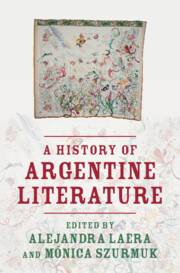Book contents
- A History of Argentine Literature
- A History of Argentine Literature
- Copyright page
- Contents
- Figures
- Contributors
- Editors’ Acknowledgments
- Introduction
- Part I Literary Dates
- Part II Critical Inroads
- Chapter 11 Print Culture in the Nineteenth Century
- Chapter 12 Criollismo: Gauchos in Literature and Film
- Chapter 13 Race and Nation
- Chapter 14 Science in Argentine Literature
- Chapter 15 Essay and Territory: The Geography of National Identity
- Chapter 16 Music as Sonic Literature
- Chapter 17 The Jewish Presence in Argentine Literature
- Chapter 18 Emancipation: Twentieth-Century Female Writers, Journalists, and Activists
- Chapter 19 Forsaking Tradition: Dislocating the Sovereignty of Argentine Literature
- Chapter 20 Mujeres raras: Patriarchal Nightmares, Dissident Imagination
- Part III Literary Names
- Index
- References
Chapter 12 - Criollismo: Gauchos in Literature and Film
from Part II - Critical Inroads
Published online by Cambridge University Press: 09 May 2024
- A History of Argentine Literature
- A History of Argentine Literature
- Copyright page
- Contents
- Figures
- Contributors
- Editors’ Acknowledgments
- Introduction
- Part I Literary Dates
- Part II Critical Inroads
- Chapter 11 Print Culture in the Nineteenth Century
- Chapter 12 Criollismo: Gauchos in Literature and Film
- Chapter 13 Race and Nation
- Chapter 14 Science in Argentine Literature
- Chapter 15 Essay and Territory: The Geography of National Identity
- Chapter 16 Music as Sonic Literature
- Chapter 17 The Jewish Presence in Argentine Literature
- Chapter 18 Emancipation: Twentieth-Century Female Writers, Journalists, and Activists
- Chapter 19 Forsaking Tradition: Dislocating the Sovereignty of Argentine Literature
- Chapter 20 Mujeres raras: Patriarchal Nightmares, Dissident Imagination
- Part III Literary Names
- Index
- References
Summary
After the publication of Eduardo Gutiérrez’s Juan Moreira (1879), its successful theatricaladaptation, and the numerous narratives about rebellious gauchos that followed, the set ofpractices and discourses that create a sense of belonging around the figure of the gaucho hascome to be known under the umbrella term of criollismo. Although recent research has shownthat criollismo did not disappear in the early twentieth century but converted to other nonliterary media, no approach considers the relationship between criollismo and cinema in thelong term and on a global level. In doing just this, this chapter focuses on the crossingbetween criollismo and cinema by looking at the images of the nation that gaucho-themed filmsbring into play. It explores how a repertoire of themes, characters, arguments, and landscapesdisseminated by criollista literature was adapted to film, projected globally in Hollywood movies, and then reappropriated by the local culture. Finally, it argues that this feedbackbetween criollista literature and film was fruitful until the late 1970s, when – after reaching a high level of violence – the political uses of criollismo became less massive and more sporadic.
- Type
- Chapter
- Information
- A History of Argentine Literature , pp. 184 - 200Publisher: Cambridge University PressPrint publication year: 2024



